Care tips and advice
These plants are happiest with lots of light, but that doesn’t always mean direct sun. Find out more about the ideal growing conditions and care tips to make sure your plant has a long and happy life.
Lemon tree

Citrus × limon
Light: Lemon trees enjoy plenty of sunlight to grow well and produce delicious fruit. Place your tree near a window that receives at least 6 hours of direct sunlight per day. We suggest a south-facing window.
Watering: Keep the compost consistently moist but not waterlogged and allow the top 2-3 inches of compost to dry out before watering again. It's important not to overwater your lemon tree as this can harm the roots. Ensure the pot has holes to allow excess water to drain out.
Humidity: Lemon trees enjoy a humid environment, more so than the average home humidity level. To increase humidity, you can mist the leaves regularly or place a humidifier nearby.
Temperature: These trees prefer warmer temperatures, ideally between 18°C to 29°C. Protect them from cold drafts in winter and extreme heat in summer.
Fertiliser: Feed your lemon tree with a fertiliser that is high in nitrogen in summer. Follow the instructions on the fertiliser package. Fertilising with a winter citrus feed less frequently in the colder months.
Pruning: Prune any dead or damaged leaves or branches to encourage new growth. You can also prune to shape the tree but be careful not to over-prune, as this can stress the tree.
Repotting: Repot your lemon tree into a larger pot every couple of years to accommodate its growing root system. We recommend repotting in late spring.
Pests: Keep an eye out for common pests such as aphids, red spider mite and scale.
Edible: Fruits
Sweet basil
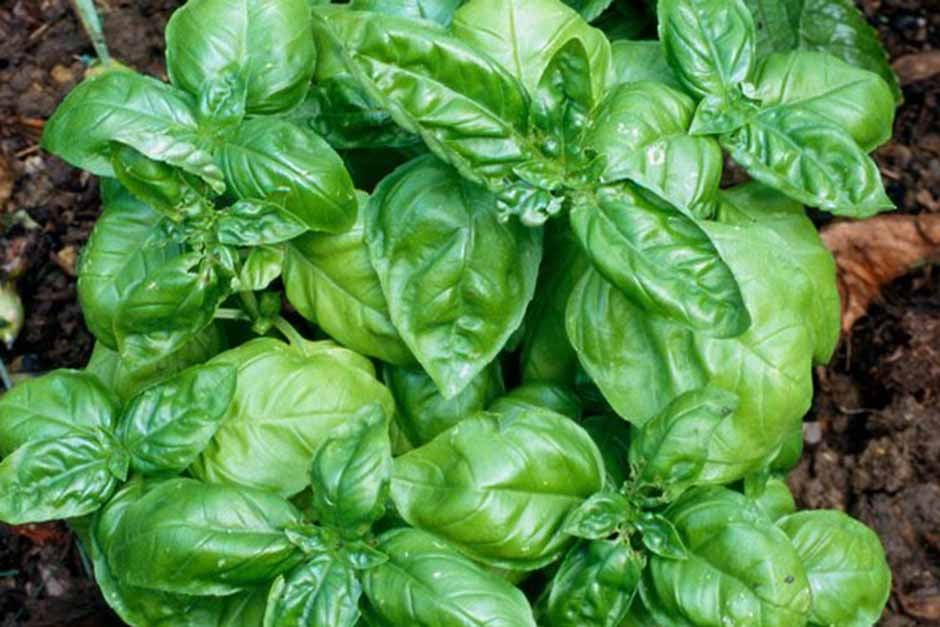
Ocimum basilicum
Light: Basil thrives in bright light, needing at least 6 hours of sunlight per day. Place your basil plant near a south-facing window for optimal growth. If natural light is limited, consider using a grow light.
Watering: Keep the compost consistently moist, but not soggy. Water your basil plant when the few centimetres of compost feels dry to the touch. It's crucial to avoid overwatering, as this can lead to root rot.
Humidity: Basil does well in regular household humidity levels but appreciates a bit of extra humidity. Misting the leaves occasionally or placing a water tray near the plant can help increase humidity.
Temperature: Basil prefers warmer temperatures, ideally between 21°C to 27°C during the day, and not dropping below 10°C at night. Protect it from drafts and sudden temperature changes.
Fertiliser: Basil greatly benefits from regular feed. Use a general-purpose liquid fertiliser h during the growing season (April to August). Reduce feeding in September when growth slows down.
Pruning: Regular pruning encourages bushier growth and prevents the plant from becoming leggy (and gives your dishes an elevated taste!) You can also pinch off the tip of the stems just above a pair of leaves to promote branching. Also, pinch off any flowers or flower buds that appear to encourage leaf growth instead of the plant putting all of its energy into producing flowers.
Repotting: Basil doesn’t usually require repotting if grown as annuals, but will sometimes last a bit longer into winter. However, if you’re keeping basil and it is getting tricky to keep the compost in the pots moist, pot them into a larger container. This will also help to replenish nutrients.
Pests: Basil can be susceptible to pests such as aphids and whiteflies.
Edible: stems and leaves.
Pepper plant
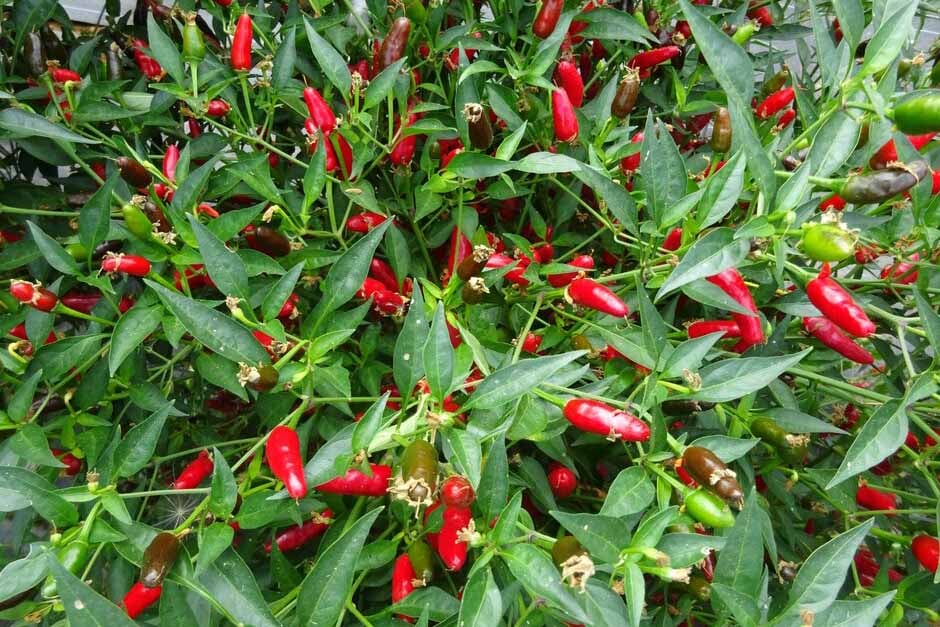 Capsicum
Light:
Capsicum
Light: Pepper plants need a lot of sunlight to flourish. Position your plant in a spot that receives at least 6 to 8 hours of direct sunlight daily. A south-facing window is often the best location inside a home.
Watering: Water the plant when the top inch of compost feels dry to the touch. Pepper plants prefer consistent moisture but do not do well in waterlogged compost. Ensure the pot has good drainage to prevent root rot.
Humidity: While pepper plants can tolerate a range of humidity levels, moderate humidity is best. If your home is very dry, consider placing a humidifier nearby or using a pebble tray with water to increase humidity around the plant.
Temperature: These plants enjoy warm conditions, ideally between 21°C to 29°C during the day, with slightly cooler temperatures at night. Protect them from cold drafts and sudden temperature changes.
Fertiliser: Feed every during the growing season (April to September) following the instructions on the pack. Reduce feeding in autumn and winter as the plant growth slows.
Pruning: Pruning is not typically necessary for pepper plants, but you can remove any dead or yellowing leaves to encourage healthier growth. Pinching off the first few blossoms can also help the plant to focus energy on becoming more bushy and therefore a better pepper yield.
Repotting: Repot your pepper plant if it becomes root-bound or the growth seems to have slowed significantly. Choose a pot that is 2-5cm larger than the current one. Repotting is best done in the spring.
Pests: Keep an eye out for pests like aphids, thrips and whiteflies that like to suck sap from stems and the underside of leaves.
Edible: The fruits are edible but there are ornamental varieties not for consumption.
Beware: this plant is a skin and eye irritant for both humans and pets.
Pineapple
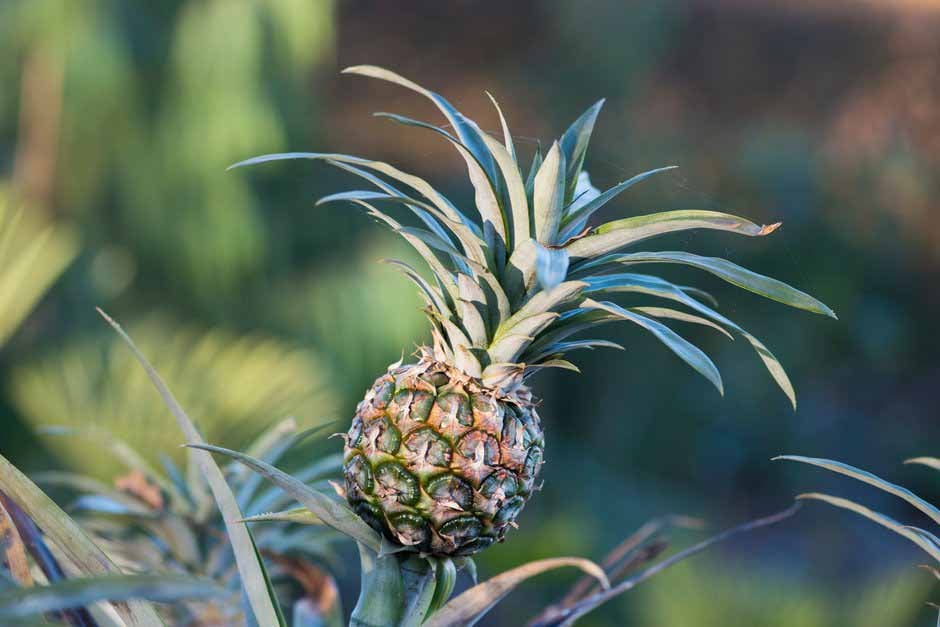 Ananas comosus
Light:
Ananas comosus
Light: Pineapple plants love light. They require around 6-8 hours of bright, indirect sunlight each day. A south-facing window is ideal, but if natural light is insufficient, consider supplementing with grow lights.
Watering: Allow the top few centimetres of compost to dry out before watering again. Pineapple plants prefer consistent moisture but do not like to be waterlogged. Water the plant at its base to avoid getting water into the rosette as this can cause rot.
Humidity: These tropical plants enjoy high humidity. If your home is dry, especially in winter, use a humidifier or place the pot on a pebble tray filled with water to increase the surrounding humidity.
Temperature: Pineapple plants thrive in warm conditions, with ideal temperatures ranging between 18°C to 30°C. They can tolerate temperatures as low as 15°C but should be protected from cold drafts and frost.
Fertiliser: Feed every during the growing season (April to September) at half the rate stated on the instructions on the pack. Reduce feeding further in autumn and winter as the plant growth slows.
Pruning: Pruning is generally not necessary for pineapple plants, but you can remove any dead or damaged leaves to maintain the plant’s appearance and health.
Repotting: Repotting is seldom required as pineapple plants enjoy being a bit root-bound. If necessary, repot in spring into a slightly larger pot with fresh, well-draining peat-free compost.
Pests and Diseases: Keep an eye out for common pests such as scale, mealybug and red spider mite.
Edible: Fruits
Croton
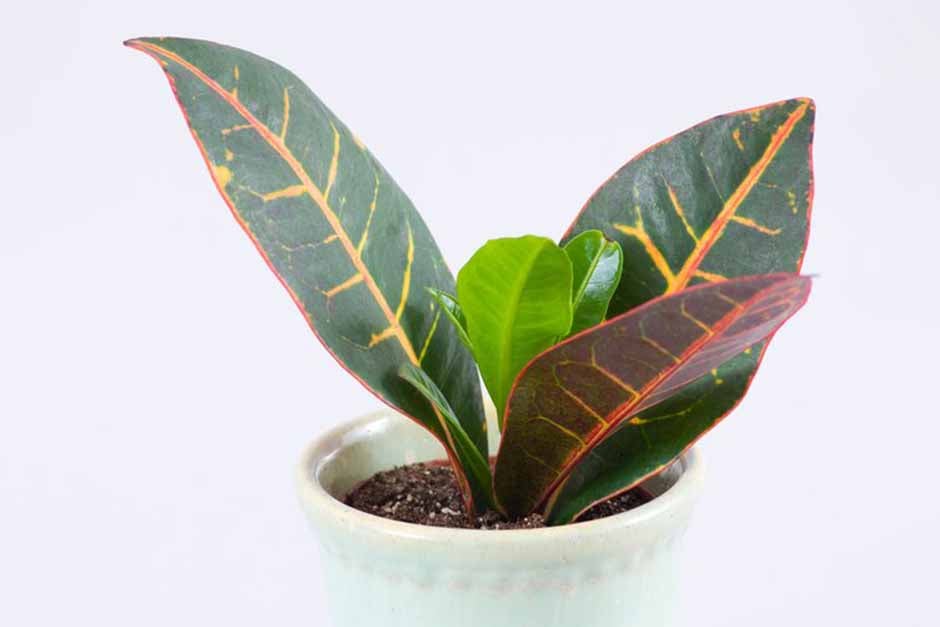 Codiaeum variegatum
Light:
Codiaeum variegatum
Light: Croton plants require bright, indirect light to maintain their colourful leaves. A spot near a south or east-facing window is ideal. Just be careful not to keep this plant too close to sunlight as their leaves are susceptible to scorching. On the other hand, too little light can cause the colours to fade and the plant to become leggy.
Watering: Keep the compost evenly moist but not waterlogged. Water the plant when the few centimetres of compost feels dry to the touch. Crotons are sensitive to fluoride and chlorine in tap water, so use filtered or distilled water if possible. Overwatering can lead to root rot, so ensure that the pot has good drainage.
Humidity: These plants prefer high humidity levels. If your home is dry, especially in the winter months, use a humidifier, mist the leaves regularly, or place the pot in a bathroom or kitchen.
Temperature: Croton plants enjoy warm temperatures, ideally between 16°C to 29°C. Protect them from drafts and sudden temperature changes, which can cause leaf drop.
Fertiliser: Feed every during the growing season (April to September) following the instructions on the pack. Reduce feeding in autumn and winter as the plant growth slows.
Pruning: Pruning is not necessary but can help maintain the plant’s shape and encourage fuller growth. Use clean, sharp shears to trim any leggy growth or remove dead leaves.
Repotting: Repot your croton every 1-2 years or when it becomes root-bound. Choose a pot that is slightly larger than the current one and use a well-draining mix of grit and peat-free compost. The best time to repot is in the spring.
Pests and Diseases: Croton plants can be susceptible to pests such as aphids, mealybug and scale insects.
Urn plant
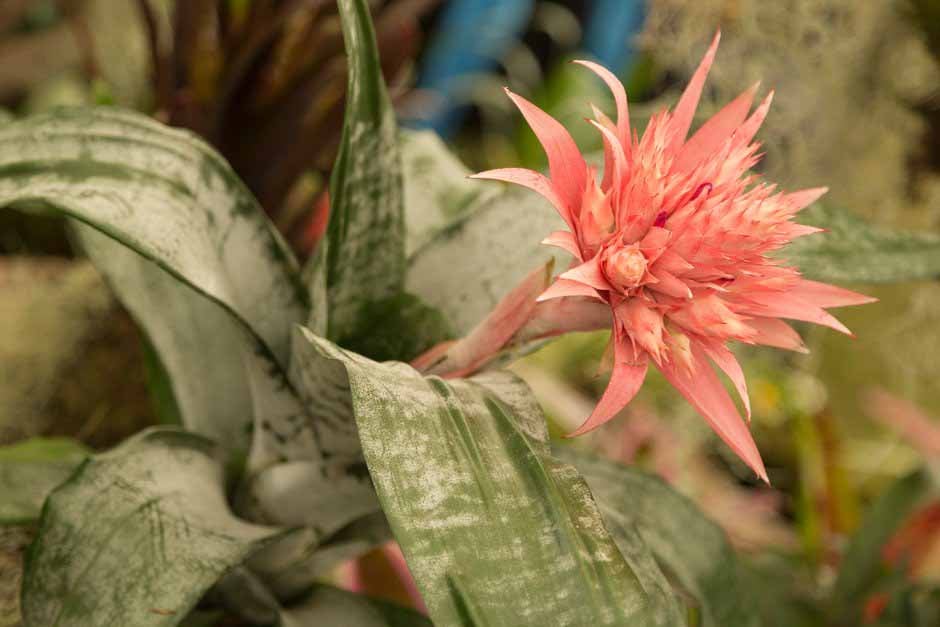 Aechmea fasciata
Light:
Aechmea fasciata
Light: Aechmea fasciata prefers bright, indirect light. A spot near an east or west-facing window is ideal, as direct sunlight can scorch its leaves, while too little light may hinder flowering.
Watering: Unlike many plants, Aechmea fasciata absorbs water through its central vase as well as its roots. Keep the central vase filled with water, changing it every few weeks to prevent stagnation and bacterial growth. Water the compost only when the top few centimetres feels dry to the touch. This will help to reduce the chance of root rot,
Humidity: This bromeliad enjoys high humidity, which can be achieved by misting the plant regularly, placing it in a bathroom or using a humidifier in very dry environments.
Temperature: Aechmea fasciata thrives in warm conditions, with ideal temperatures ranging from 16°C to 27°C. Protect it from cold drafts and temperatures below 16°C, which can cause damage.
Fertiliser: Feed your aechmeas with a half-strength, liquid feed every month during the spring and summer months. Do not apply fertiliser directly into the central vase but instead to the compost.
Pruning: There’s no need to prune aechmeas. Simply remove dead or damaged leaves at the base to maintain its appearance. After the plant flowers, it will eventually die back, leaving you with offsets (pups) which can be separated and repotted to grow new plants.
Repotting: Aechmea fasciata rarely needs repotting. If you do decide to repot, choose a container that is slightly larger than the current one and use a well-draining compost mix suitable for bromeliads or orchids. Repotting is best done in spring or early summer.
Pests and Diseases: This plant is relatively disease-resistant, but watch for common pests such as scale and mealybug.
Rose grape
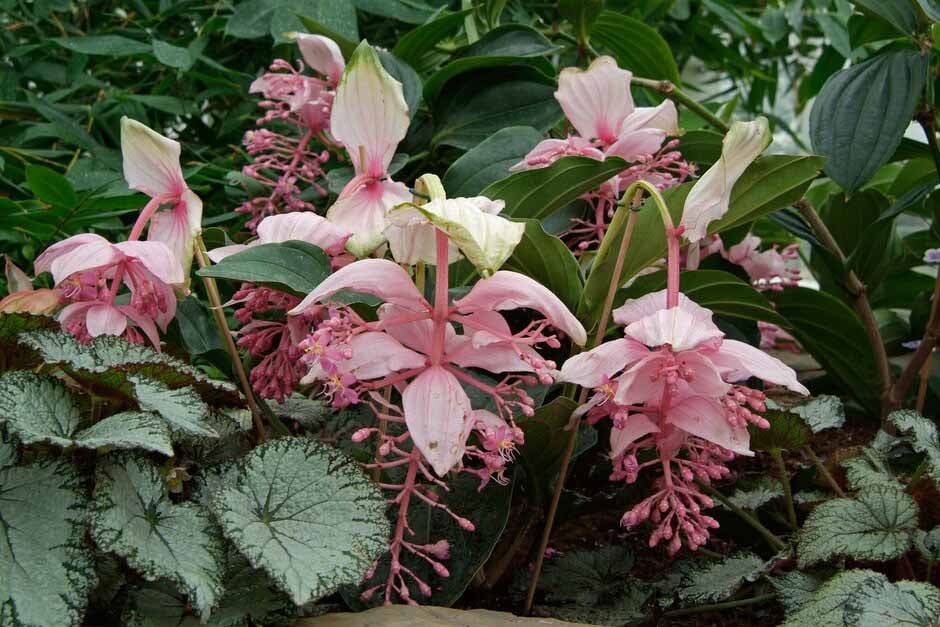 Medinilla magnifica
Light: Medinilla magnifica
Medinilla magnifica
Light: Medinilla magnifica thrives in bright, indirect light. Too much direct sunlight can scorch its leaves, while too little light can hinder bloom production. A spot near an east or west-facing window, shaded from intense midday sun, is ideal.
Watering: Keep the compost consistently moist during the growing season (spring and summer), but not waterlogged. Allow the top few centimetres of compost to dry out slightly before watering again. Reduce watering in the autumn and winter months as the plant slows down in growth and therefore requires less water. Overwatering can lead to root rot, so ensure the plant has adequate drainage.
Humidity: This plant thrives in high humidity. If your home is dry, especially during winter, you can increase humidity by placing a humidifier nearby, misting the plant regularly, or placing the pot on a pebble tray filled with water.
Temperature: This beautiful plant prefers warm temperatures between 18°C to 24°C during the day and slightly cooler at night. Protect it from drafts and sudden temperature changes to prevent stress.
Fertiliser: Feed every during the growing season (April to September) following the instructions on the pack. Reduce feeding in autumn and winter as the plant growth slows.
Pruning: After blooming, prune back the flower stalks to encourage new growth and maintain the plant’s shape. You can also trim any yellow or damaged leaves to keep the plant healthy and attractive.
Repotting: Repot
Medinilla magnifica every two to three years or when it becomes root-bound. Use a peat-free houseplant compost and a pot just one size larger than the current one.
Pests and Diseases: Be on the lookout for pests such as aphids, red spider mite and mealybug.
Jade plant
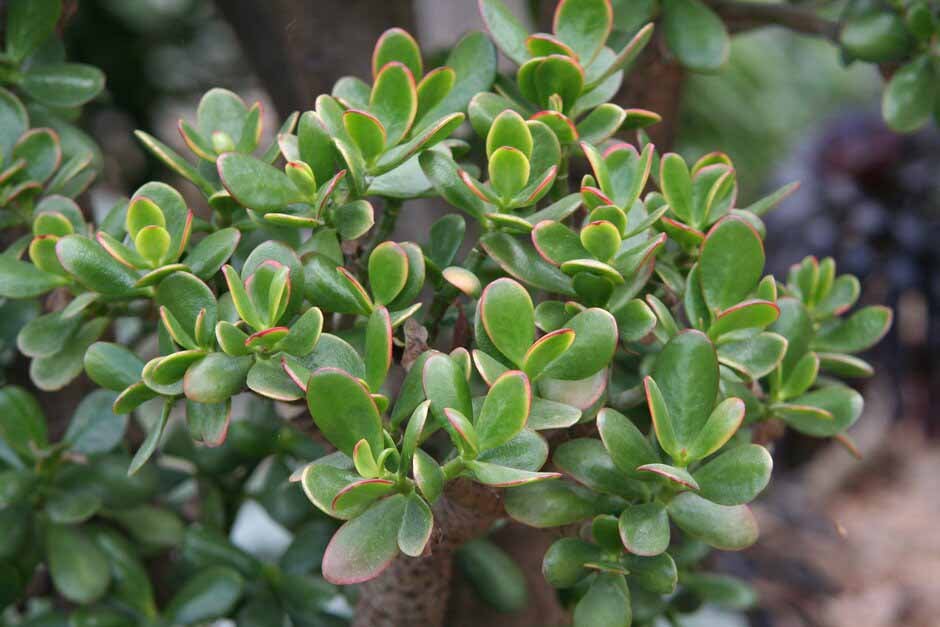 Crassula ovata
Light:
Crassula ovata
Light: Jade plants are super easy care houseplants that can thrive in almost any environment. That being said, they do prefer bright, indirect sunlight to thrive. A location near a south-facing window where the plant receives around 5 hours of light is ideal. If the light is too intense, it may cause leaf scorch, whereas insufficient light can lead to leggy growth.
Watering: Allow the compost to dry out completely between waterings. As a succulent whose waxy leaves are great at retaining water, overwatering this plant can cause more harm than good. Water thoroughly, then wait until the compost is dry before watering again. In winter, reduce watering frequency as the plant’s growth slows down. Avoid overwatering to prevent root rot.
Humidity: Crassula ovata does not require high humidity and is quite adaptable to average indoor conditions. There’s no need for misting or special humidity measures.
Temperature: Jade Plants prefer room temperatures from 18°C to 24°C during the day and cooler at night, but not below 10°C. Protect them from drafts and drastic temperature changes.
Fertiliser: Feed every during the growing season (April to September) following the instructions on the pack. Do not feed in the autumn and winter as growth is minimal.
Pruning: Pruning can help maintain a bushier, more attractive shape and encourage growth. Use clean, sharp scissors to remove any leggy branches or to shape the plant as desired. Pruning is best done in spring or early summer and these off cuts can easily be propagated by pushing them back into the compost.
Repotting: Repot your jade plant every two to three years or when it becomes root-bound. Use a well-draining potting mix intended for succulents or cacti. Our top tip would be to choose a pot with adequate drainage holes to prevent water accumulation.
Pests and Diseases: Keep an eye out for common pests such as spider mites, mealybugs, and aphids.
Aloe vera
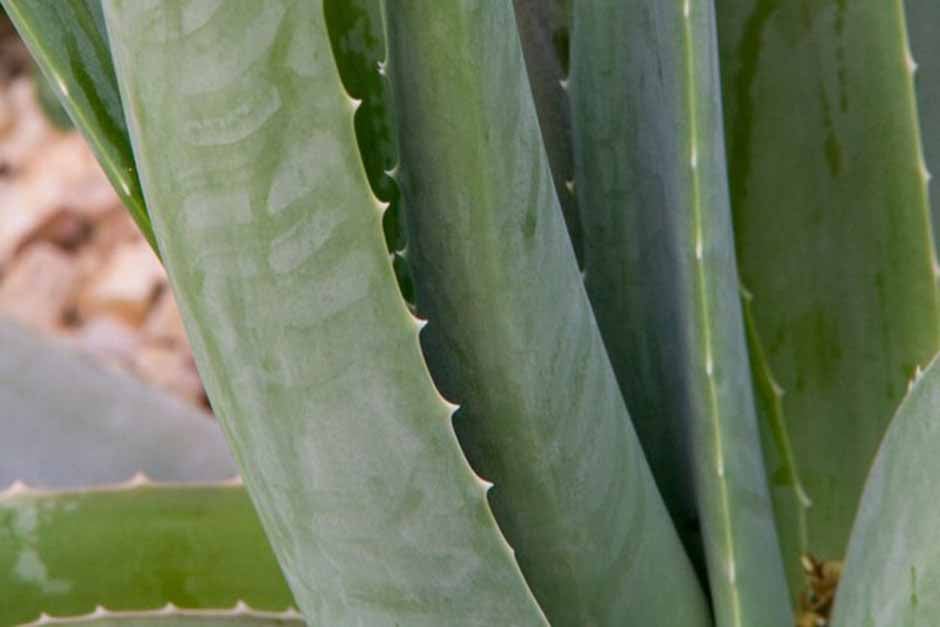
Aloe vera
Light: Aloe vera plants thrive in bright, indirect sunlight. Place them near a south or west-facing window where they can receive plenty of light without being exposed to harsh direct sunlight, which can cause their leaves to brown.
Watering: Water deeply but infrequently, allowing the compost to dry out completely between waterings. Overwatering is the most common issue with Aloe vera, leading to root rot. During winter, reduce watering to a minimum as the plant enters a dormant period. Avoid overwatering to prevent fungal diseases and root rot.
Humidity: Aloe vera does not require high humidity and is quite adaptable to the average indoor environment. Avoid misting the leaves, as this can increase the risk of rot.
Temperature: Keep your Aloe vera in a warm spot with temperatures between 13°C to 27°C. Protect it from cold drafts and frost, which can damage the plant.
Fertiliser: Fertilise sparingly, using a general-purpose liquid food diluted to half the recommended strength. Feed the plant once in the spring and again in late summer, avoiding over-fertilisation.
Pruning: Pruning is not generally required for Aloe vera, but you can remove any dead or damaged leaves at the base to keep the plant looking tidy. Use a clean, sharp knife or scissors for pruning.
Repotting: Repot Aloe vera plants every 2-3 years or when they become root-bound. Use a well-draining potting mix designed for succulents or cacti, and choose a pot with adequate drainage holes to prevent water accumulation.
Pests and Diseases: Aloe vera plants are susceptible to pests such as scale insects, mealybug and red spider mite.
Beware: this plant is harmful if eaten for humans and pets.
Prickly pear
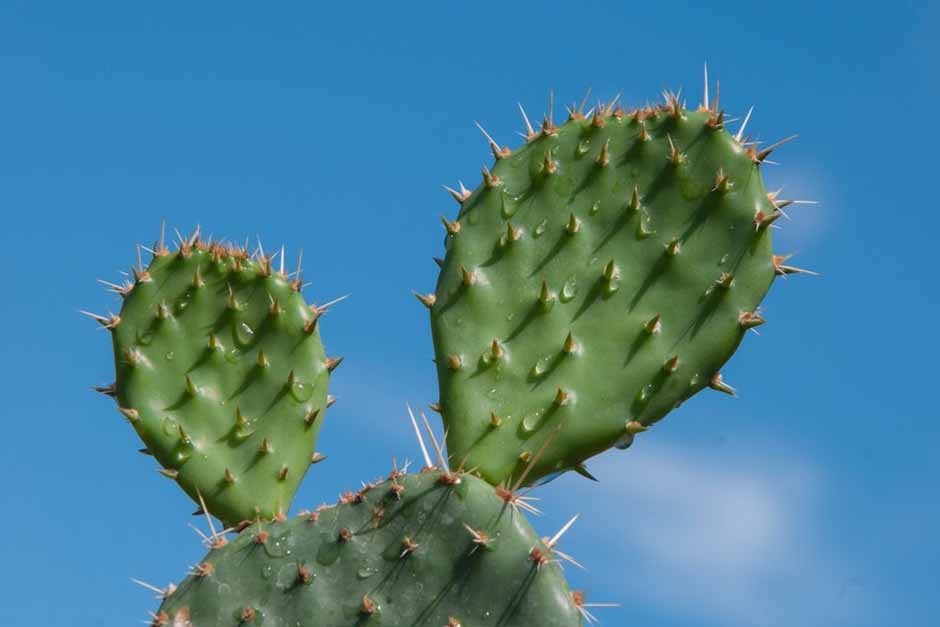 Opuntia microdasys
Light: Opuntia
Opuntia microdasys
Light: Opuntia are commonly known as prickly pear plants and are cacti that require full sun to partial shade. Place this plant in a spot where it can get at least 6 hours of direct sunlight daily. A south or west-facing window is ideal for indoor plants to ensure they receive enough light.
Watering: Water the
Opuntia sparingly, allowing the compost to dry out completely between waterings. Be sure not to saturate the compost for too long as this can lead to root rot. During the winter, water even less frequently to mimic the plant’s natural dormant period. Avoid overwatering to prevent root rot and other fungal diseases.
Humidity: Opuntia cacti thrive in low-humidity environments typical of indoor conditions. They are well-suited to the dry air found in most homes and do not require additional humidity.
Temperature: These cacti prefer warm temperatures during the growing season and cooler temperatures in the winter. They can tolerate a wide range of temperatures, from about 10°C at night to 35°C during the day.
Fertiliser: Fertilise your
Opuntia with a cactus fertiliser during the growing season (April to September). Do not feed for the rest of the year while the plant’s growth is slow.
Pruning: Pruning is not typically necessary for health but can be done to shape the plant or control its size. Use tongs or wear gloves to handle the plant and avoid the spines.
Repotting: Repot every 2-3 years or when the plant outgrows its pot. Use a well-draining compost mix designed for cacti and succulents. Choose a pot with good drainage holes to prevent water accumulation and make sure to handle it with care.
Pests and Diseases: Opuntia can be susceptible to pests like scale insects and mealy bug.
Beware: this plant is a skin and eye irritant for humans and pets.
African milk tree
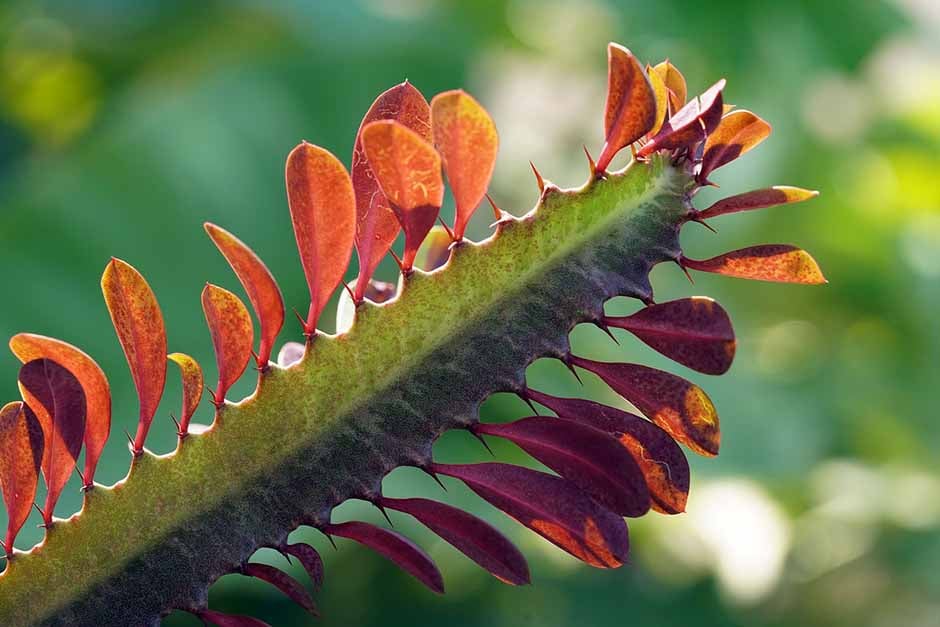 Euphorbia trigona
Light:
Euphorbia trigona
Light: Most euphorbia species thrive in bright, indirect light to partial shade. They can tolerate some direct sunlight, but too much can cause leaf scorch or discoloration, especially in hot climates.
Watering: Water euphorbias sparingly. Allow the compost to dry out completely between waterings. These plants are drought-tolerant and susceptible to root rot if overwatered. During the winter months, reduce watering further to mimic their natural dormant period. Overwatering and poor drainage are the main causes of root rot in euphorbias.
Humidity: Euphorbias generally prefer low to average humidity levels, which makes them well-suited to indoor environments. Excessive humidity can lead to problems with rot.
Temperature: They prefer temperatures between 15°C to 24°C during the day and cooler at night but should not be exposed to temperatures below 10°C. Protect them from drafts and sudden temperature changes.
Fertiliser: Feed every during the growing season (April to September) following the instructions on the pack. Reduce feeding in autumn and winter as the plant growth slows.
Pruning: Pruning may be necessary to shape the plant or remove dead or diseased growth. Always wear gloves when handling euphorbias, as their sap can be irritating to skin and eyes.
Repotting: Repot euphorbias every 2-3 years or when they outgrow their pot. Use a well-draining, peat-free compost and a pot with good drainage holes. Repotting is best done in the spring or early summer.
Pests and Diseases: Euphorbias can be susceptible to pests such as red spider mite, mealybugs, and aphids.
Beware: this plant is harmful if eaten and a skin and eye irritant for humans and pets.
White bird of paradise
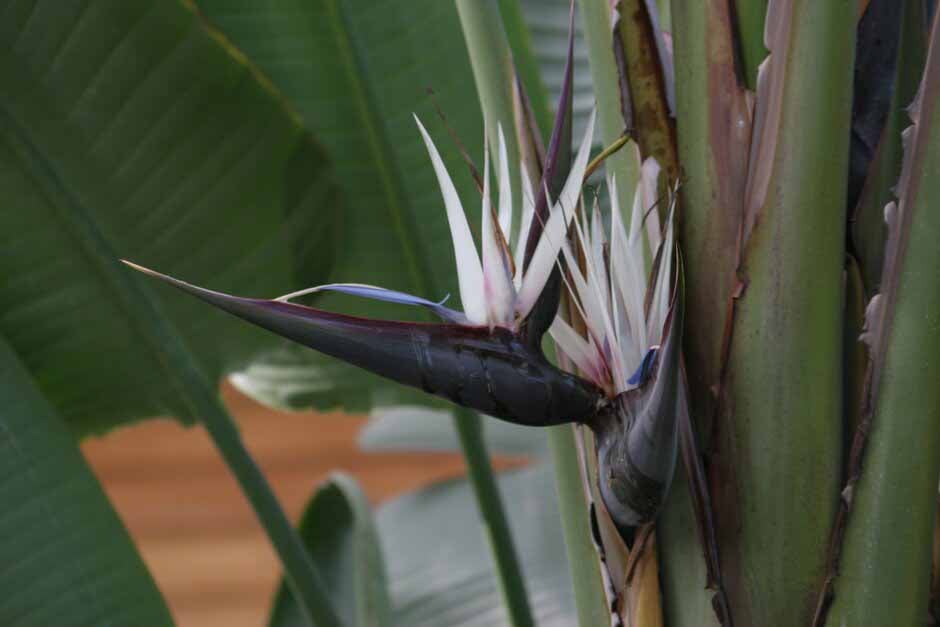
Strelitzia reginae
Light: Strelitzia reginae, also known as bird of paradise, requires bright, indirect light to thrive. A spot near a south or west-facing window where the plant can receive plenty of light without being exposed to harsh direct sunlight is ideal. If the plant doesn’t get enough light, it may not produce flowers.
Watering: Keep the compost consistently moist but not waterlogged during the growing season (spring and summer). Allow the few centimetres of compost to dry out before watering again. Reduce watering in the fall and winter when the plant’s growth slows down. Overwatering is a common cause of root rot with these tropical plants, so ensure your pot has good drainage.
Humidity: These plants prefer higher humidity levels. If your home is dry, especially during winter, increase humidity by using a humidifier, misting the leaves regularly, or placing the pot on a pebble tray filled with water.
Temperature: Bird of paradise plants enjoy warm temperatures, ideally between 18°C to 29°C. They can tolerate a minimum of 10°C but should be protected from cold drafts and sudden temperature changes.
Fertiliser: Feed every during the growing season (April to September) following the instructions on the pack. Reduce feeding in autumn and winter as the plant growth slows. Feeding is essential for flower production in mature plants.
Pruning: Pruning is not typically necessary for health but can be done to remove any damaged or dying leaves. Use clean, sharp scissors or pruners, and wear gloves to protect your hands.
Repotting: Repot the bird of paradise every 2-3 years or when it becomes root-bound. Spring is the best time for repotting. Use a well-draining potting mix and a pot just slightly larger than the current one to encourage growth.
Pests and Diseases: Be on the lookout for pests such as red spider mite, mealybug and scale.
String of hearts
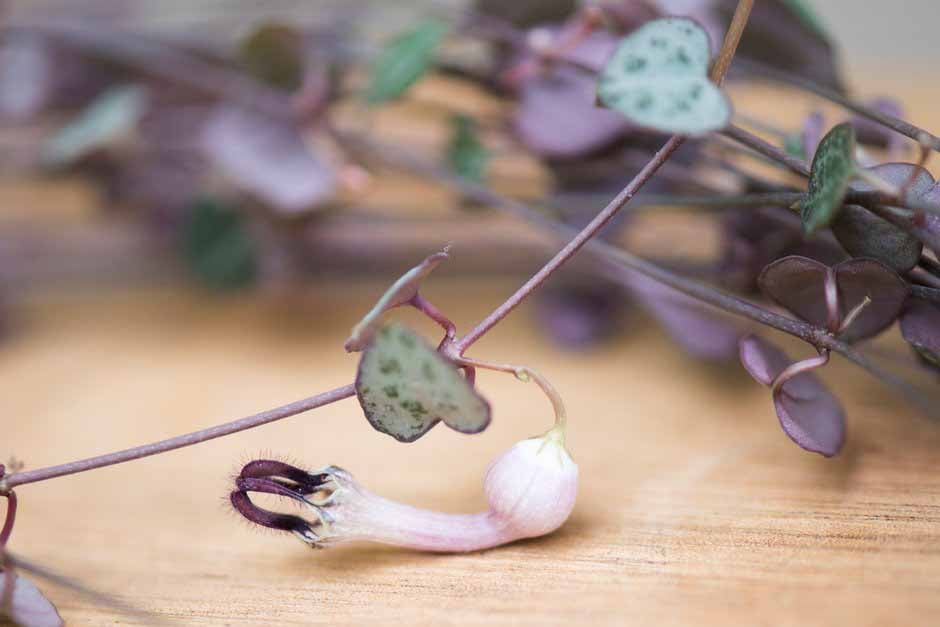
Ceropegia linearis subsp. woodii
Light: String of Hearts prefers bright, indirect light. Too much direct sunlight can scorch the leaves, while too little light can cause the plant to become leggy and lose its vibrant colouration. A spot near a window with filtered light is ideal.
Watering: Allow the compost to dry out completely between waterings. This plant is drought-tolerant, thanks to its succulent-like leaves that store water. During the winter, reduce watering frequency as the plant’s growth slows.
Humidity: String of Hearts does well in average household humidity levels but can benefit from a bit of extra humidity. If your home is very dry, consider using a humidifier or placing a pebble tray with water near the plant to increase humidity slightly.
Temperature: It prefers warmer temperatures, ideally between 15°C to 27°C. Protect it from drafts and extreme temperature changes to avoid stress on the plant.
Fertiliser: Feed every during the growing season (April to September) following the instructions on the pack. No feeding is required in autumn and winter.
Pruning: Pruning is not typically necessary but can be done to encourage fuller growth or maintain a desired shape. Simply trim the vines with clean scissors to the length you prefer.
Repotting: Repotting is only necessary every few years or when the plant becomes root-bound. Choose a pot only slightly larger than the current one and use a well-draining potting mix, ideally formulated for succulents or cacti.
Pests and Diseases: These are usually trouble free, but look out for pests such as mealy bug.
Many-flowered jasmine
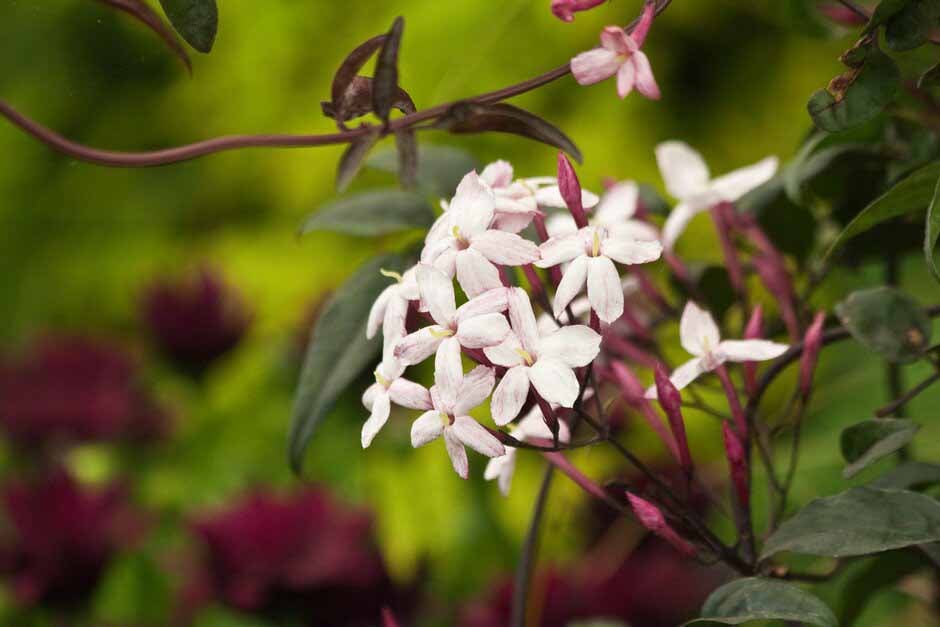
Jasminum polyanthum
Light: Jasminum polyanthum prefers bright, indirect light. It can tolerate some direct sunlight, especially during the less intense morning hours. Too much direct sunlight can scorch its leaves, so a spot near an east-facing window is ideal.
Watering: Keep the compost consistently moist but not waterlogged. Water when the few centimetres of compost feels dry to the touch. Reduce watering in the winter when the plant’s growth slows.
Humidity: This jasmine variety enjoys high humidity. If your indoor air is dry, especially in winter, use a humidifier, mist the plant regularly, or place the pot on a pebble tray filled with water to increase humidity around the plant.
Temperature: Jasminum polyanthum prefers cooler temperatures, ideally between 15°C to 24°C during the day and cooler at night. This temperature drop is particularly important for bud formation.
Fertiliser: Feed every during the growing season (April to September) following the instructions on the pack. Reduce feeding in autumn and winter as the plant growth slows.
Pruning: After blooming, prune the plant to encourage branching and maintain a desired shape. Regular pruning helps promote more blooms as jasmine flowers on new wood.
Repotting: Repot in the spring if the plant becomes root-bound if growth is poor. Use a well-draining potting mix and a pot that is one size larger than the current one.
Pests and Diseases: Be on the lookout for common pests such as aphids and whiteflies.
Find out more...

